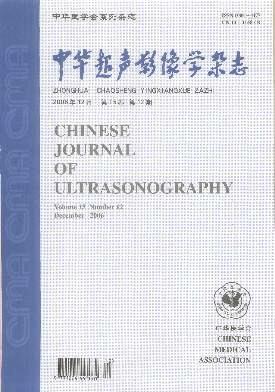The clinical study of character types of sentinel lymph nodes in patients with breast cancer in lymphatic contrast enhanced ultrasound
Q4 Medicine
引用次数: 0
Abstract
Objective To evaluate the diagnostic efficiency in differential diagnosis for breast sentinel lymph nodes, and to analyze the imaging characteristics of involved breast sentinel lymph node in lymphatic contrast enhanced ultrasound. Methods Sixty-one patients suspected with breast cancer from May 2017 to March 2019 in Shanghai General Hospital, Shanghai Jiao Tong University were included in the study. Ultrasound contrast agent was injected subcutaneously, and axillary lymph nodes were displayed under contrast enhanced ultrasound mode. The longitudinal diameter (anteroposterior diameter), transverse diameter, longitudinal/transverse ratio and the distance from skin surface were measured. Five types were concluded according to the imaging characteristics in lymphatic contrast enhanced ultrasound: typeⅠ, uniform enhancement; type Ⅱ, ring-shape enhancement; type Ⅲ, ununiform enhancement; type Ⅳ, regional filling defect; type Ⅴ, total filling defect. Sentinel lymph nodes were guided by wire guides and verified in pathology after excision in the operation. Results The detection rate of sentinel lymph nodes was 95.08% (58/61). Seventy-seven lymph nodes, including 21 involved nodes and 56 uninvolved nodes were detected by lymphatic contrast enhanced ultrasound in 58 patients. The longitudinal diameters and transverse diameters of involved lymph nodes were larger than those of uninvolved ones (P=0.001, 0.003). When type Ⅳ(regional filling defect) and type Ⅴ(total filling defect) were classified as involved, the sensitivity, specificity, positive-predictive value, negative-predictive value, accuracy and the area under ROC curve of predicting sentinel lymph node metastases were 85.71%, 96.43%, 90.00%, 94.70%, 93.51% and 0.911, respectively. Conclusions Lymphatic contrast enhanced ultrasound reaches a high diagnostic efficiency in qualitative analysis of breast sentinel lymph nodes. Regional filling defect and total filling defect are the imaging characteristics of involved sentinel lymph nodes in lymphatic contrast enhanced ultrasound. Key words: Contrast-enhanced ultrasound; Breast cancer; Sentinel lymph node; Differential diagnose; Diagnostic efficiency乳腺癌症前哨淋巴结特征类型的淋巴增强超声临床研究
目的评价乳腺前哨淋巴结的鉴别诊断效率,分析淋巴管增强超声对受累乳腺前哨淋巴结清扫的影像学特征。方法对上海交通大学上海总医院2017年5月至2019年3月收治的61例癌症疑似患者进行研究。皮下注射超声造影剂,在增强超声模式下显示腋窝淋巴结。测量纵向直径(前后径)、横向直径、纵向/横向比以及与皮肤表面的距离。根据淋巴管造影的影像学特点,归纳出五种类型:Ⅰ型,均匀增强;Ⅱ型,环状强化;Ⅲ型,不均匀强化;Ⅳ型,区域性充填缺陷;Ⅴ型,全充填缺陷。前哨淋巴结由导丝引导,并在手术切除后进行病理学验证。结果前哨淋巴结检出率为95.08%(58/61)。58例患者经淋巴管增强超声检查发现77个淋巴结,其中受累淋巴结21个,未受累淋巴结56个。受累淋巴结的纵径和横径均大于未受累淋巴结(P=0.001,0.003)。将Ⅳ型(局部充盈缺损)和Ⅴ型(全充盈缺损)分为受累淋巴结时,其敏感性、特异性、阳性预测值、阴性预测值,预测前哨淋巴结转移的准确率和ROC曲线下面积分别为85.71%、96.43%、90.00%、94.70%、93.51%和0.911。结论淋巴造影增强超声对乳腺前哨淋巴结的定性分析具有较高的诊断效率。淋巴管造影超声显示前哨淋巴结受累的影像学特征为局部充盈缺损和全充盈缺损。关键词:超声造影;癌症;哨兵淋巴结;鉴别诊断;诊断效率
本文章由计算机程序翻译,如有差异,请以英文原文为准。
求助全文
约1分钟内获得全文
求助全文
来源期刊

中华超声影像学杂志
Medicine-Radiology, Nuclear Medicine and Imaging
CiteScore
0.80
自引率
0.00%
发文量
9126
期刊介绍:
 求助内容:
求助内容: 应助结果提醒方式:
应助结果提醒方式:


